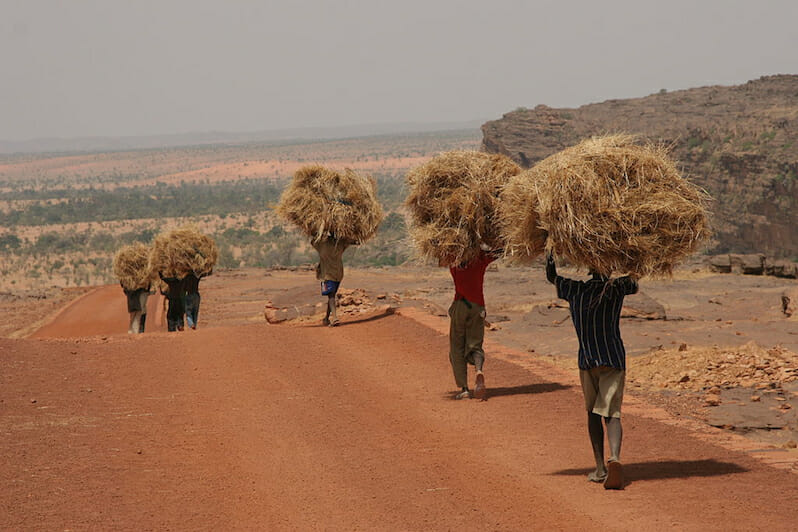Drought-Stricken African Region May Finally Bloom, Thanks to Incoming Monsoon
European scientists say there is hope that a parched swath of Africa could suddenly start to receive heavy seasonal rainfall. In the arid Sahel, young Malians carry home straw to feed their animals. (Ferdinand Reus / Wikimedia Commons)
In the arid Sahel, young Malians carry home straw to feed their animals. (Ferdinand Reus / Wikimedia Commons)
By Tim Radford / Climate News Network
In the arid Sahel, young Malians carry home straw to feed their animals. (Ferdinand Reus / Wikimedia Commons)
European scientists say there is hope that a parched swathe of Africa could suddenly start to receive heavy seasonal rainfall, with the countries south of the Sahara desert watered by a Sahel monsoon. The Sahel is an arid zone hit by decades of drought and famine.
If the planetary temperatures rise beyond the 1.5°C to 2°C limit proposed by the Paris agreement signed by 197 nations in 2015, then climate change could arrive in Mali, Niger and Chad in the shape of intense rains of the kind identified as seasonal monsoons.
Nations that could be described as almost-desert would get the kind of rainfall expected in central Nigeria or northern Cameroon, where the vegetation is rich and vigorous.
“More rain in a dry region can be good news,” said Jacob Schewe, a co-author of the study from the Potsdam Institute for Climate Impact Research (PIK).
Shake-up
“Climate change due to greenhouse gases from burning fossil fuels really has the power to shake things up. It is driving risks for crop yields in many regions and generally increases dangerous weather extremes around the globe, yet in the dry Sahel there seems to be a chance that further warming might indeed enhance water availability for farming and grazing.”
Schewe’s co-author Anders Levermann, from PIK and the Lamont-Doherty Earth Observatory at New York’s Columbia University, said: “We don’t know what the impacts on the ground will be, this is beyond the scope of our study; but imagine the chance of a greening Sahel.
“Still, the sheer size of the possible change is mind-boggling – this is one of the very few elements in the Earth system that we might witness tipping soon. Once the temperature approaches the threshold, the rainfall regime could shift within just a few years.”
Rain increases
The two scientists report, in the journal Earth System Dynamics, that they looked at a series of climate change simulations and found seven that predicted more rain for the Sahel later in this century as temperatures rose beyond the 2°C target: in some cases 40% more rain, in other simulations up to 300% more.
Findings like this are always provisional, and come with a note of caution. But the mechanism for torrential rains in the desert is a simple one: higher temperatures mean more evaporation of the oceans and more rain over the land, which releases heat and increases the temperature difference between the cooler oceans and the warmer landmasses.
That will draw more moisture-laden winds into the interior, which will produce more rain. The challenge is to guess where the rain will fall, and keep on falling.
“Temperatures have to go beyond a certain point to start this process,” Dr Schewe said. “We find that the threshold for this Sahel monsoon is remarkably similar. It seems to be a robust finding.”
Tipping point
Such a dramatic shift in a climate pattern would constitute what climate scientists call a tipping point: a sudden shift from one predictable pattern of weather to another.
Such change has been predicated for the Arctic, and scientists have repeatedly warned of yet further shifts if the world does not act to sharply reduce greenhouse gas emissions from fossil fuel use.
But, broadly, climate scientists have warned that those climates already wet are likely to see higher levels of rainfall, and those already dry will get drier: by the century’s end, more than half the terrestrial planet could be characterised as dryland, they have warned, and the Sahel could expect more drought and famine.
But, paradoxically, researchers have also already identified an increase in sudden heavy rainstorms in the Sahel.
And far to the south, climate change could already be affecting the Congo rainforest, which is now noticeably hotter and less moist. The researchers talk of “a northward expansion of the West African monsoon domain.” The problem is: how do farmers, foresters and herdsmen in Africa adapt to any shift in climate?
“The enormous change that we might see would clearly pose a huge adaptation challenge to the Sahel. From Mauritania and Mali in the west to Sudan and Eritrea in the east, more than 100 million people are potentially affected that already now are confronted with a multifold of instabilities, including war,” Professor Levermann said.
“Particularly in the transition period between the dry climatic conditions of today and the conceivably much wetter conditions at the end of our century, the Sahel might experience years of hard-to-handle variability between drought and flood.
“Obviously, agriculture and infrastructure will have to meet this challenge. As great as it hopefully were for the dry Sahel to have so much more rain, the dimension of the change calls for urgent attention.”
Your support matters…Independent journalism is under threat and overshadowed by heavily funded mainstream media.
You can help level the playing field. Become a member.
Your tax-deductible contribution keeps us digging beneath the headlines to give you thought-provoking, investigative reporting and analysis that unearths what's really happening- without compromise.
Give today to support our courageous, independent journalists.






You need to be a supporter to comment.
There are currently no responses to this article.
Be the first to respond.